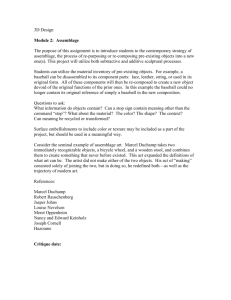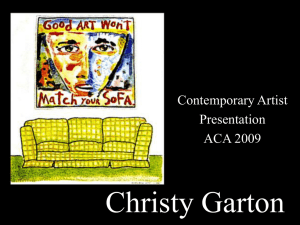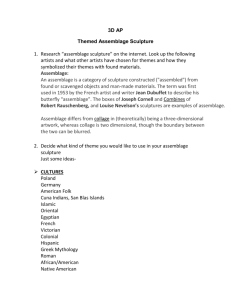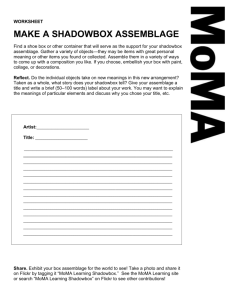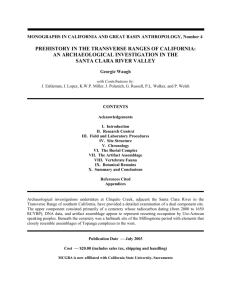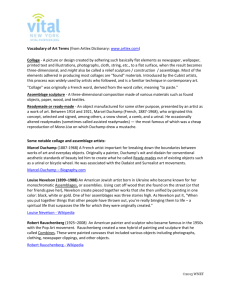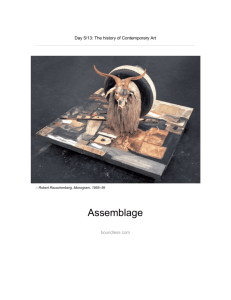Assemblage - HistorylearningJasonPrice
advertisement
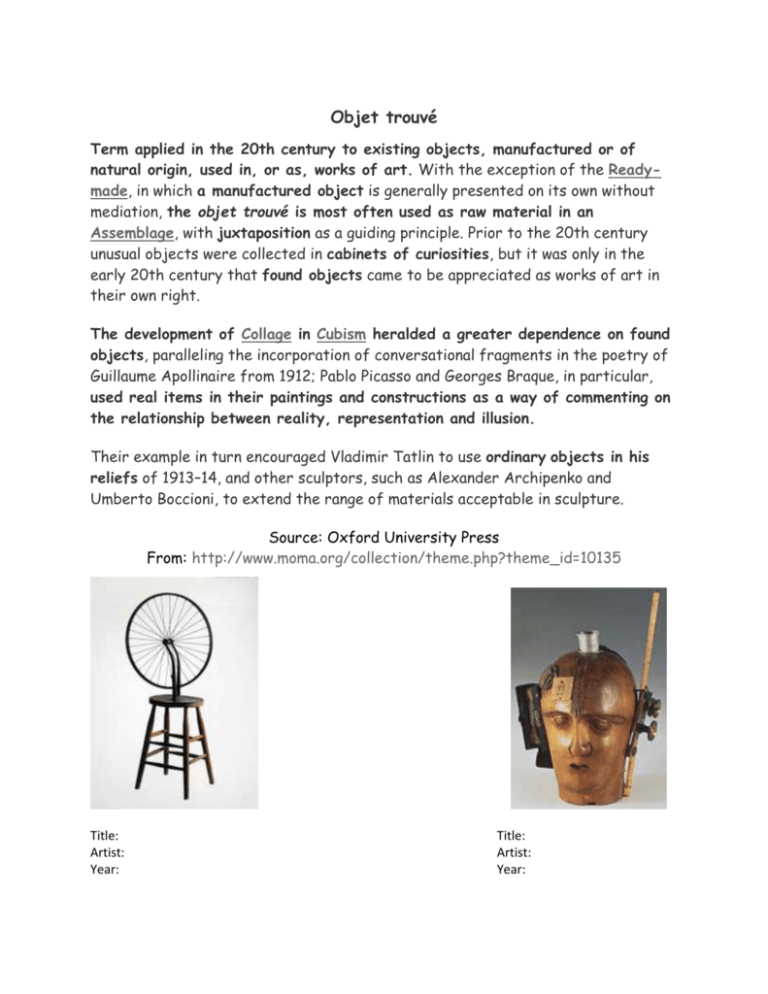
Objet trouvé Term applied in the 20th century to existing objects, manufactured or of natural origin, used in, or as, works of art. With the exception of the Readymade, in which a manufactured object is generally presented on its own without mediation, the objet trouvé is most often used as raw material in an Assemblage, with juxtaposition as a guiding principle. Prior to the 20th century unusual objects were collected in cabinets of curiosities, but it was only in the early 20th century that found objects came to be appreciated as works of art in their own right. The development of Collage in Cubism heralded a greater dependence on found objects, paralleling the incorporation of conversational fragments in the poetry of Guillaume Apollinaire from 1912; Pablo Picasso and Georges Braque, in particular, used real items in their paintings and constructions as a way of commenting on the relationship between reality, representation and illusion. Their example in turn encouraged Vladimir Tatlin to use ordinary objects in his reliefs of 1913–14, and other sculptors, such as Alexander Archipenko and Umberto Boccioni, to extend the range of materials acceptable in sculpture. Source: Oxford University Press From: http://www.moma.org/collection/theme.php?theme_id=10135 Title: Artist: Year: Title: Artist: Year: Assemblage Art form in which natural and manufactured, traditionally non-artistic, materials and objets trouvés are assembled into three-dimensional structures. As such it is closely related to Collage, and like collage it is associated with Cubism, although its origins can be traced back beyond this. As much as by the materials used, it can be characterized by the way in which they are treated. In an assemblage the banal, often tawdry materials retain their individual physical and functional identity, despite artistic manipulation. The term was coined by Jean Dubuffet in 1953 to refer to his series of butterfly-wing collages and series of lithographs based on paper collages, which date from that year. Although these were in fact collages, he felt that that term ought to be reserved for the collage works of Braque, Picasso and the Dadaists of the period between 1910 and 1920. By 1954 Dubuffet had extended the term to cover a series of three-dimensional works made from primarily natural materials and objects. The concept of assemblage was given wide public currency by the exhibition The Art of Assemblage at MOMA, New York, in 1961. This included works by nearly 140 international artists, including Braque, Joseph Cornell, Dubuffet, Marcel Duchamp, Picasso, Robert Rauschenberg, Man Ray and Kurt Schwitters. Several of the works shown were in fact collages, but the breadth of styles and artists included reflects the wide application of the term and the sometimes fine distinction between assemblage and collage. The ‘combine paintings’ of Rauschenberg, for example, fall awkwardly between the two, being essentially planar but with often extensive protrusions of objects. The inclusion of real objects and materials both expanded the range of artistic possibilities and attempted to bridge the gap between art and life. The ancestry of the assemblage can be traced back to the artistic and literary environment of late 19th-century France. In his later poetry, especially Un Coup de dés jamais n’abolira le hasard (1897), Stéphane Mallarmé adopted a technique in which poetic fragments were pieced together in unusual semantic and typographic arrangements. Guillaume Apollinaire later extended this method in his Calligrammes (1918). By emphasizing the visual appearance of words their traditional role of signification was both enhanced and expanded. In the same manner assemblage emphasizes the visual or tactile qualities of formerly utilitarian objects while nevertheless exploiting the perception of the banality of such objects. This development expressed a dissatisfaction with the deceptive illusionism of painting and sculpture that was overcome by the use of real objects. Another equally important pioneer of assemblage was Kurt Schwitters, who used the technique in his Merz works. Merz Construction (1921; Philadelphia, PA, Mus. A.), for example, was made from pieces of wood, wire mesh, paper and cardboard to create a deliberately ugly, shabby work characteristic of Schwitters’s Dadaist aesthetic. The ready-mades of Marcel Duchamp showed a similar anti-artistic intent, and little if any actual assembly was required for their production. The facility with which objects could be juxtaposed in assemblage made the medium ideally suited to the Surrealists in their quest for the marvellous. The Surrealist object thus became an important part of the movement’s output, allowing a material equivalent to the juxtaposition of distant entities embodied in the Surrealist image, as in Meret Oppenheim’s fur-lined cup and saucer, Object (1936; New York, MOMA). From the 1950s worthless or discarded materials were used in assemblage to various effect by Robert Rauschenberg and other American artists. Richard Stankiewicz used junk metal in such welded assemblages as Kabuki Dancer (1954; New York, Whitney), in which the parts assume a menacing quality that can be seen as a comment on technological society. The exponents of Nouveau Réalisme also produced a range of assemblage works. For example Daniel Spoerri’s tableaux pièges, such as Table City Galerie (1965; Amsterdam, Stedel. Mus.), were often made from the refuse of meals, illustrating human consumption and, more broadly, the consumer society. This theme was developed more consistently in Pop art, which emphasized the synthetic, brash nature of mass-produced consumer products. The assemblage proved an effective way of realizing this aim, as shown, for example, by Tom Wesselmann’s Still Life #40 (1964; Saint-Etienne, Mus. A. & Indust.), which used brightly coloured synthetic materials. The environmental works of Edward Kienholz, such as The Beanery (1965; Amsterdam, Stedel. Mus.), used assemblage on a much larger scale and broke radically with the residual sculptural connotations of assemblage by literally surrounding the viewer and recreating reality in a distorted form. The continued use of the assemblage into the 1990s showed it to be a medium almost as flexible and important in modern art as painting or the traditional technique of sculpture. Philip Cooper From Grove Art Online © 2009 Oxford University Press From: http://www.moma.org/collection/theme.php?theme_id=10057

